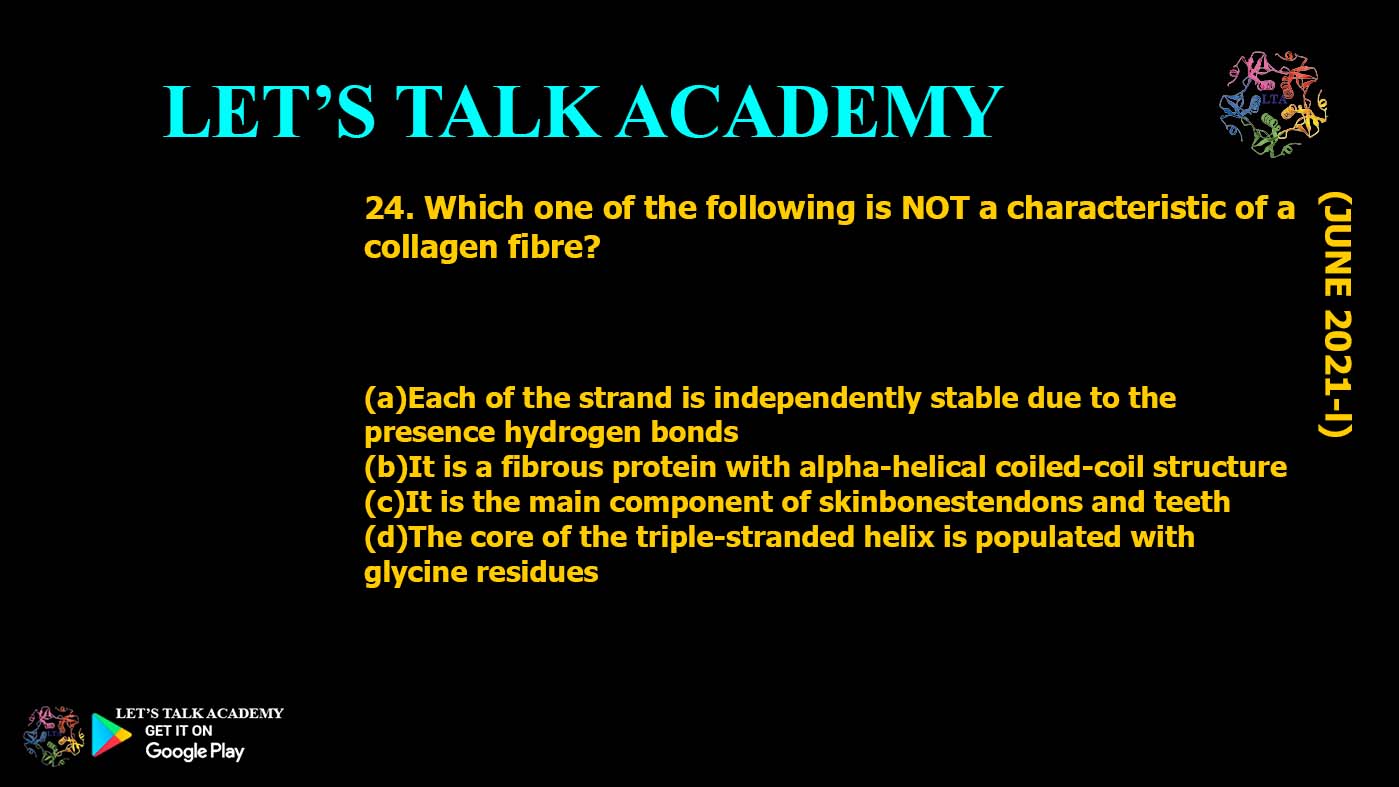24. Which one of the following is NOT a characteristic of a collagen fibre?
(a)Each of the strand is independently stable due to the presence hydrogen bonds
(b)It is a fibrous protein with alpha-helical coiled-coil structure
(c)It is the main component of skinbonestendons and teeth
(d)The core of the triple-stranded helix is populated with glycine residues
Introduction
Characteristics and Functions of Collagen Fibers
Collagen is one of the most abundant proteins in the human body, found in connective tissues such as skin, bones, tendons, and teeth. It plays a crucial role in providing structural integrity, elasticity, and strength to various tissues. Collagen fibers are known for their unique structural features, which allow them to function effectively in these diverse roles.
In this article, we will discuss the key characteristics of collagen fibers, and which of the given options is NOT a characteristic of collagen.
Key Characteristics of Collagen Fibers
-
Triple-Helical Structure:
Collagen fibers are composed of three polypeptide chains, each wrapped in a right-handed helix. These three strands are wound together to form a triple-stranded helix, which is essential for the structural stability of collagen. This helical structure is stabilized by hydrogen bonds between the strands. -
Glycine Residues in the Core:
The central core of the collagen triple-helix is rich in glycine residues. Glycine, being the smallest amino acid, fits neatly into the restricted spaces within the helix, allowing the three strands to pack closely together. This is a critical feature that contributes to the stability and strength of collagen. -
Fibrous Nature and Strength:
Collagen is a fibrous protein that forms long, thread-like structures, providing tensile strength to tissues. These fibers are extremely strong and resistant to stretching, making them ideal for tissues that need to withstand physical stress, such as tendons, ligaments, and skin. -
Function in Body Tissues:
Collagen fibers are the main structural components of skin, bones, tendons, and teeth. In skin, collagen provides strength and elasticity; in bones, it contributes to bone density; in tendons and ligaments, it provides tensile strength for movement and flexibility; and in teeth, it is essential for dentin and enamel structure.
Breaking Down the Options
Now, let’s examine each option to determine which one is NOT a characteristic of collagen fibers:
-
(a) Each of the strands is independently stable due to the presence of hydrogen bonds:
This statement is true. The stability of collagen comes from the hydrogen bonds between the individual strands of the triple helix, making each strand stable and integral to the overall structure. -
(b) It is a fibrous protein with alpha-helical coiled-coil structure:
This statement is incorrect. Collagen is a fibrous protein, but it does not have an alpha-helical coiled-coil structure. Instead, it has a triple-helix structure. The alpha-helix is characteristic of other proteins such as keratin, not collagen. -
(c) It is the main component of skin, bones, tendons, and teeth:
This statement is true. Collagen is the primary structural protein in these tissues, contributing significantly to their strength and integrity. -
(d) The core of the triple-stranded helix is populated with glycine residues:
This statement is true. Glycine is indeed the most abundant amino acid in the central core of the collagen triple helix. Its small size allows the three polypeptide chains to pack tightly together, which is essential for the stability of the structure.
The Correct Answer:
The statement that is NOT a characteristic of collagen fibers is:
(b) It is a fibrous protein with alpha-helical coiled-coil structure
Conclusion
Collagen fibers are an essential component of the body’s connective tissues, providing strength, support, and elasticity. The key characteristics of collagen, such as its triple-helix structure, the presence of glycine residues in the core, and its role as a fibrous protein in tissues like skin, bones, tendons, and teeth, make it an indispensable protein for structural integrity.
While collagen shares some features with other fibrous proteins like keratin, it is important to note that collagen does not adopt an alpha-helical coiled-coil structure, as indicated in the incorrect option. Understanding these fundamental aspects of collagen helps explain its diverse and critical functions in the human body.




3 Comments
Akshay mahawar
April 24, 2025Done 👍
Vaidehi Sharma
April 30, 2025Done✅
yogesh sharma
May 8, 2025Done sir